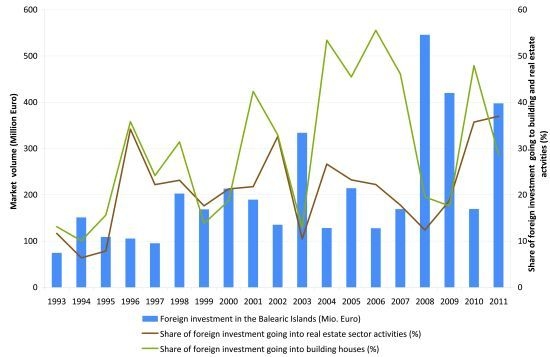The Linkages between Real Estate Tourism and Urban Sprawl in Majorca (Balearic Islands, Spain)
Abstract
:1. Introduction
1.1. Residential Tourism and Urban Sprawl in a Wider Context
1.2. Majorca as a Case Study for the Nexus between Tourism, Land Change and Urban Sprawl
1.3. Objectives and Outline of the Paper
2. Market and Policy Mainstreams on Tourism and Land Use Planning
2.1. Real Estate Tourism Shift

2.2. Transport Megaprojects Influence
2.3. Changes with the Crisis in the Land Use Regulatory Planning
3. Materials and Methods
- Creation of new urban fabric (1990–2006, hectares per km2 urban fabric).
- Change in urban density (1990–2006, inhabitants per km2 urban fabric).
- The creation of new urban fabric in an urban sprawl pattern is related to real estate tourism indicated by a positive correlation with the number and density of second homes at municipality level.
- Municipalities with a change in urban density have a high proportion of second homes to principal residences, because second homes are primarily located in a low-density urban fabric that has increased faster over time than population (i.e., urban density decreased over time).
- The creation of new urban fabric is related to second home development for which the absolute number and density of exurban swimming pools is indicative.
- The growing number of countryside villas, often with swimming pools, is fed by tourist and real estate investors attracted by this new product. The ongoing process of countryside villas and holiday villas’ legalization is driven by these capital investors.
- These land use changes have their main driver in the neoliberal economic and urban planning policies; particularly through the relaxation, weakening, flexibilization or lifting of regional planning to attract capital flows, exacerbated within the crisis context.
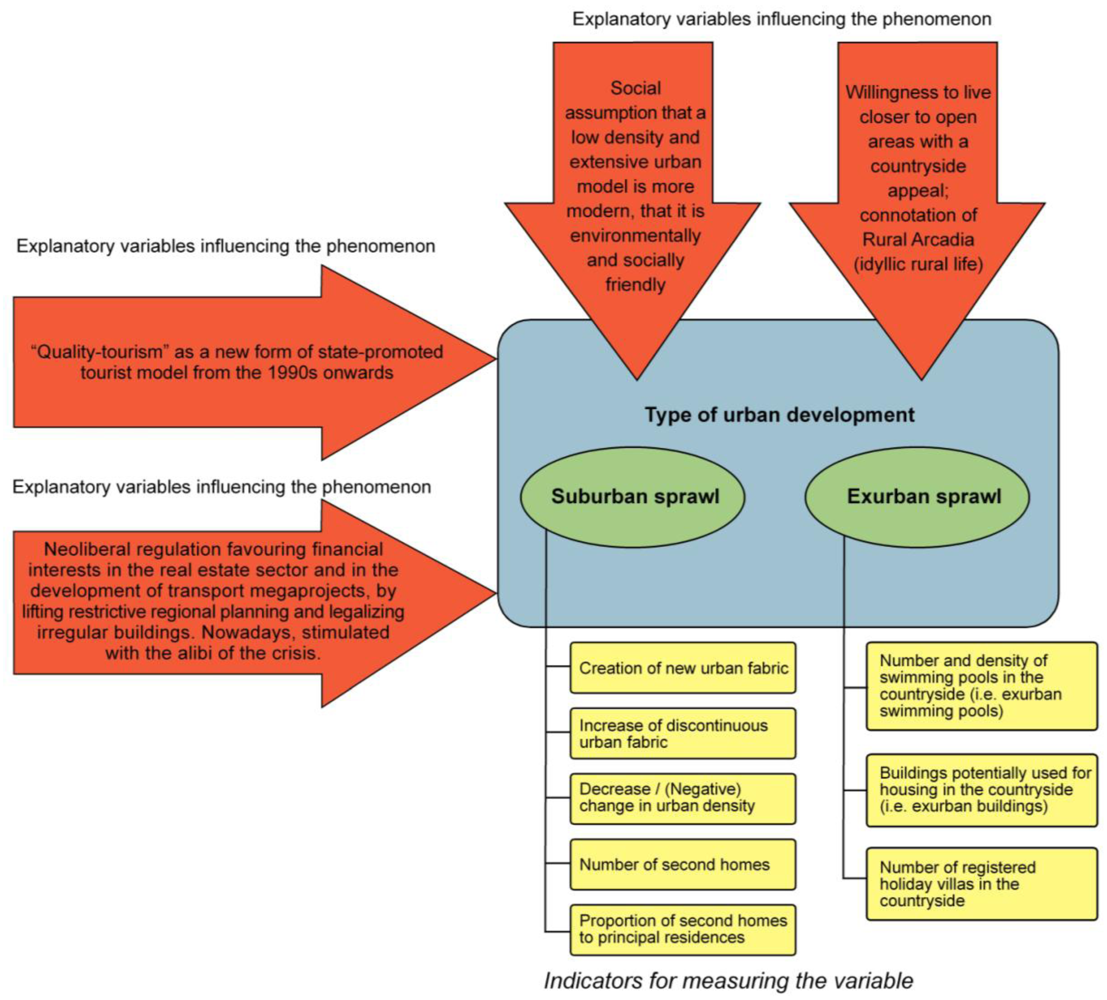
3.1. Spatial Analysis of Suburban Sprawl Processes from 1990 to 2006
3.2. Spatial Analysis of Exurban Development of Buildings and Swimming Pools in the Countryside
3.3. An Approach to the Analysis of Holiday Villas Distribution Pattern in Majorca’s Countryside
4. Results and Discussion
4.1. Urban Sprawl in Majorca (1990–2006)
| Variable | Creation of New Urban Fabric | Change in Urban Density | Number of Exurban Swimming Pools |
|---|---|---|---|
| Number of second homes | 0.398** | - | 0.528** |
| Proportion of second homes to principal residences | - | 0.335* | - |
| Density of second homes (per km2) | 0.436** | - | 0.304* |
| Number of exurban swimming pools | 0.325* | - | n.a. |
| Density of exurban swimming pools (pools/km2) | 0.498** | - | n.a. |
4.2. Urban Sprawl Patterns at Municipality Level in Majorca (1990–2006)
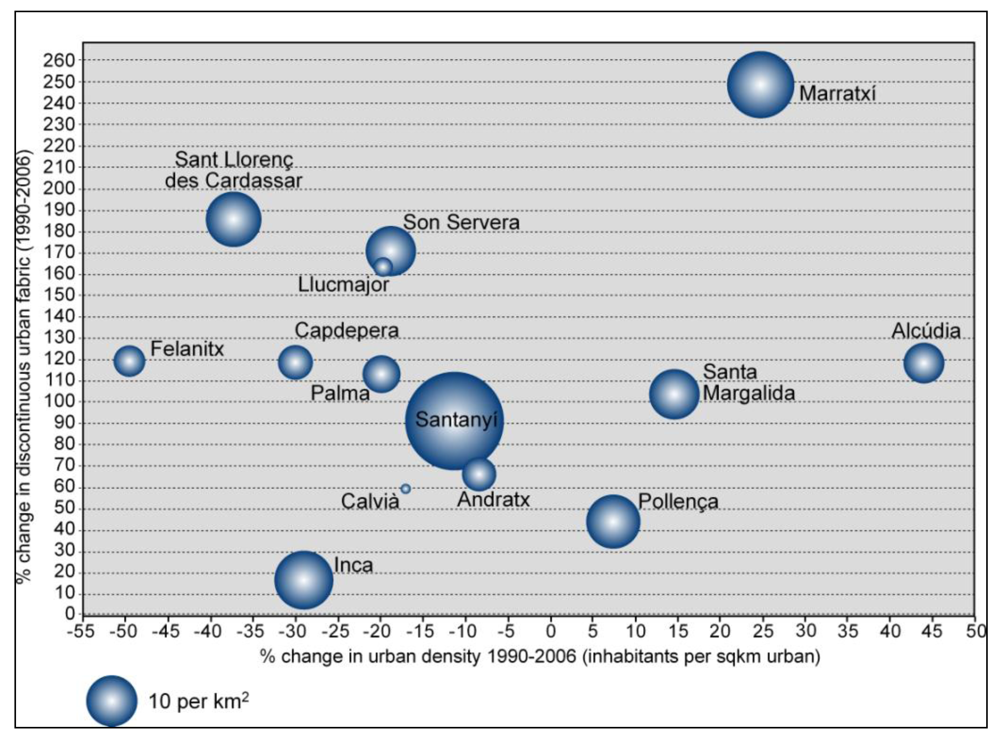
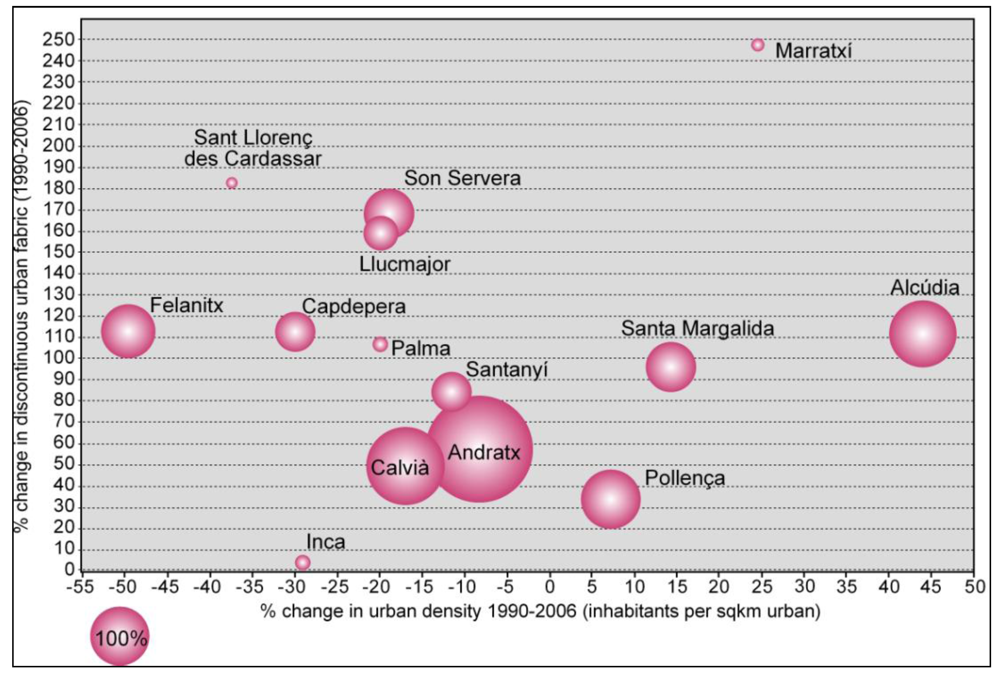
4.3. Urban Sprawl for Real Estate Tourism in Majorca: Villa Construction in Majorca’s Countryside

4.4. Holiday Villas and Swimming Pool Distribution Pattern in Majorca’s Countryside
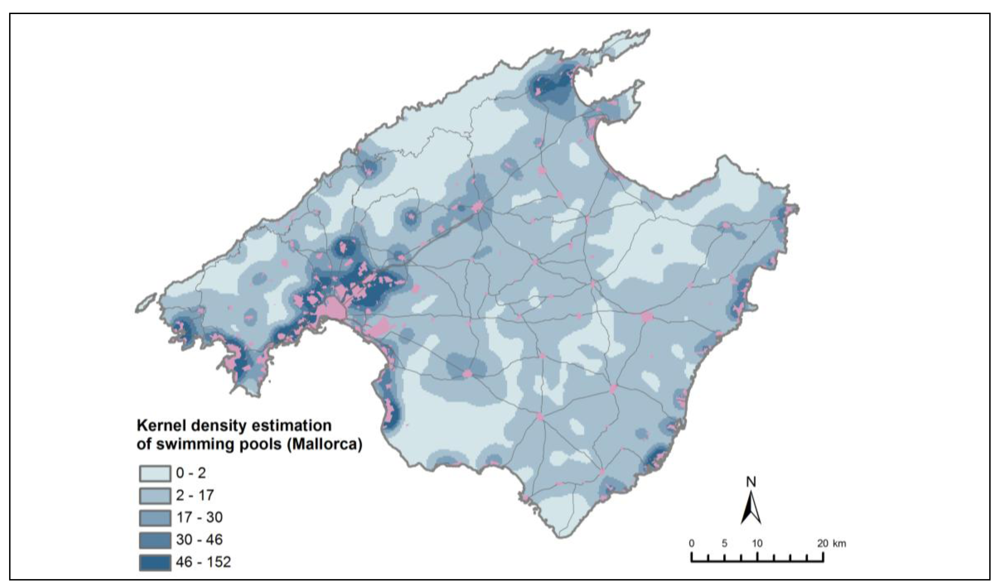
| Municipality | Municipality Area km2 | Number of Swimming Pools | Density per km2 |
|---|---|---|---|
| Pollença | 151.1 | 1,568 | 10.4 |
| Palma | 195.5 | 1,393 | 7.1 |
| Manacor | 260.0 | 1,229 | 4.7 |
| Llucmajor | 327.0 | 1,122 | 3.4 |
| Felanitx | 169.6 | 965 | 5.7 |
| Marratxí | 54.2 | 708 | 13.1 |
| Santanyí | 37.6 | 674 | 17.9 |
| Inca | 58.3 | 623 | 10.7 |
| Artà | 139.7 | 564 | 4.0 |
| Andratx | 81.4 | 540 | 6.6 |
| Sencelles | 48.7 | 517 | 10.6 |
| Algaida | 89.7 | 477 | 5.3 |
| Alcúdia | 59.9 | 433 | 7.2 |
| Bunyola | 84.6 | 407 | 4.8 |
| Son Servera | 42.5 | 399 | 9.4 |
| Sant Llorenç | 38.5 | 374 | 9.7 |
| Selva | 124.4 | 373 | 3.0 |
| Capdepera | 54.9 | 352 | 6.4 |
| Binissalem | 29.8 | 320 | 10.8 |
| Santa Maria | 86.5 | 297 | 3.4 |
| Alaró | 45.7 | 291 | 6.4 |
| Calvià | 144.9 | 243 | 1.7 |
| Campos | 149.5 | 225 | 1.5 |
| Porreres | 86.8 | 216 | 2.5 |
| Esporles | 35.3 | 196 | 5.6 |
| Santa Margalida | 20.2 | 191 | 9.4 |
| Campanet | 34.6 | 177 | 5.1 |
| Montuïri | 41.1 | 175 | 4.3 |
| Sineu | 47.7 | 175 | 3.7 |
| Sóller | 42.7 | 159 | 3.7 |
| Costitx | 15.4 | 155 | 10.1 |
| Muro | 58.6 | 154 | 2.6 |
| Lloseta | 12.1 | 149 | 12.3 |
| Ses Salines | 39.0 | 149 | 3.8 |
| Petra | 70.1 | 147 | 2.1 |
| Sant Joan | 52.8 | 126 | 2.4 |
| Valldemossa | 42.8 | 114 | 2.7 |
| Llubí | 34.9 | 109 | 3.1 |
| Puigpunyent | 48.6 | 106 | 2.2 |
| Santa Eugènia | 82.0 | 102 | 1.2 |
| Búger | 8.3 | 97 | 11.7 |
| Consell | 13.7 | 96 | 7.0 |
| Lloret | 17.4 | 94 | 5.4 |
| Deià | 15.1 | 77 | 5.1 |
| Fornalutx | 19.5 | 65 | 3.3 |
| Maria | 30.5 | 53 | 1.7 |
| Banyalbufar | 18.0 | 45 | 2.5 |
| Estellencs | 13.4 | 44 | 3.3 |
| Ariany | 23.0 | 43 | 1.9 |
| Mancor | 19.9 | 37 | 1.9 |
| Sa Pobla | 42.3 | 28 | 0.7 |
| Vilafranca | 23.9 | 21 | 0.9 |
| Escorca | 139.2 | 20 | 0.1 |
| Total | 4.5 | 18,621 | 4.1 |
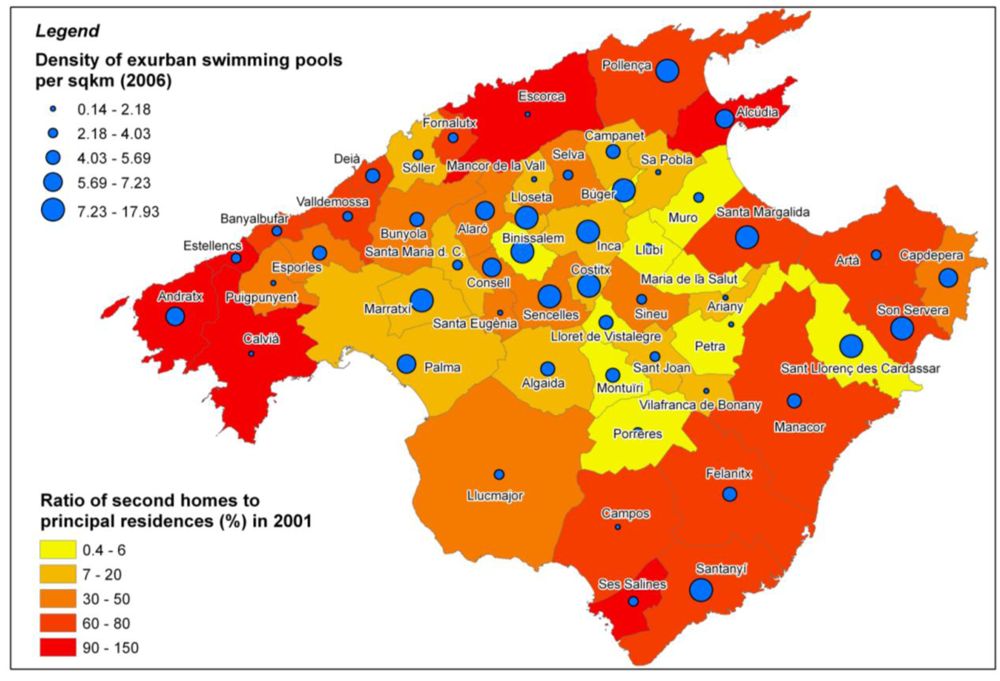
4.5. Holiday Villas Legalization Process
| Holidays Villas Open in 2010 | Number of Beds | |
|---|---|---|
| Pollença | 495 | 1,983 |
| Santanyí | 195 | 1,002 |
| Felanitx | 106 | 626 |
| Alcúdia | 72 | 248 |
| Calvià | 125 | 225 |
| Santa Margalida | 60 | 222 |
| Sant Llorenç | 50 | 198 |
| Ses Salines | 81 | 186 |
| Andratx | 54 | 179 |
| Son Servera | 33 | 164 |
| Capdepera | 46 | 148 |
| Campos | 11 | 68 |
| Manacor | 18 | 60 |
| Selva | 7 | 55 |
| Búger | 8 | 54 |
| Muro | 6 | 51 |
| Artà | 8 | 39 |
| Palma | 36 | 37 |
| Campanet | 5 | 29 |
| Inca | 3 | 27 |
| Sa Pobla | 3 | 22 |
| Sineu | 2 | 16 |
| Llucmajor | 2 | 14 |
| Sóller | 1 | 14 |
| Sencelles | 1 | 12 |
| Porreres | 1 | 8 |
| Valldemossa | 1 | 8 |
| Algaida | 1 | 6 |
| Alaró | 0 | 0 |
| Total | 1,431 | 5,701 |
5. Conclusions
Acknowledgements
Conflict of Interest
References
- Casado-Diaz, M.A. Socio-demographic impacts of residential tourism: A case study of Torrevieja, Spain. Int. J. Tourism Res. 1999, 1, 223–237. [Google Scholar] [CrossRef]
- Mantecón, A. Tourist modernisation and social legitimation in Spain. Int. J. Tourism Res. 2010, 12, 617–626. [Google Scholar]
- European Environment Agency (EEA), Urban Sprawl in Europe—The Ignored Challenge; EEA: Copenhagen, Denmark/Luxembourg, 2006.
- Barke, M. Second homes in Spain: An analysis of change at the provincial level, 1981–2001. Geography 2007, 92, 195–207. [Google Scholar]
- Parés, M.; March, H.; Saurí, D. Atlantic gardens in Mediterranean climates: Understanding the production of suburban natures in Barcelona. Int. J. Urban Reg. Res. 2012, 37, 328–347. [Google Scholar]
- Iglesias, A.; Garrote, L.; Flores, F.; Moneo, M. Challenges to manage the risk of water scarcity and climate change in the Mediterranean. Water Resour. Manag. 2007, 21, 775–788. [Google Scholar] [CrossRef]
- Buswell, R.J. Mallorca and Tourism—History, Economy and Environment; Channel View Publications: Bristol, UK, 2011. [Google Scholar]
- Bardolet, E.; Sheldon, P.J. Tourism in archipelagos: Hawai’i and the Balearics. Ann. Tourism Res. 2008, 35, 900–923. [Google Scholar] [CrossRef]
- Schmitt, T.; Blázquez, M. Der dritte tourismusboom auf Mallorca (1991–2000). Zukunftsweisender trend oder überschrittener Zenit? Tourism. J. 2003, 7, 505–522. [Google Scholar]
- European Environment Agency (EEA), Corine Land Cover (1990, 2000, 2006) Raster Data; European Environment Agency: Copenhagen, Denmark, 2012.
- Balearic Tourism Research and Technologies Centre (CITTIB), Conselleria de Turisme: Dades Informatives; Conselleria de Turisme: Palma, Spain, 2006.
- Instituto Nacional de Estatística (INE). INEbase/Demography and Population/Population Figures and Demographic Censuses—Population Figures 1970–2011; Population and Housing Census. Available online: http://www.ine.es/en/inebmenu/mnu_cifraspob_en.htm (accessed on 29 January 2013).
- Molotch, H. The city as a growth machine: Toward a political economy of place. Am. J. Sociol. 1976, 82, 309–332. [Google Scholar]
- Harvey, D. Fixed Capital, the Consumption Fund and the Accumulation of Capital. In The Limits to Capital; Verso: London, UK, 1999; pp. 235–238. [Google Scholar]
- Brenner, N.; Theodore, N. Spaces of Neoliberalism: Urban Restructuring in North America and Western Europe; Blackwell: Oxford, UK, 2002. [Google Scholar]
- López, I.; Rodríguez, E. The Spanish model. New Left Rev. 2011, 69, 3. [Google Scholar]
- Gobierno de España, Ministerio de Fomento, Estadísticas Sobre Transacciones Inmobiliarias (Compraventa) Según Residencia del Comprador. Available online: http://www.fomento.gob.es (accessed on 27 February 2013).
- Institut d’Estadística de les Illes Balears (IBESTAT). Estadísticas: Economía, Comercio e Inversión Exterior: Inversiones Exteriors. 2012. Available online: http://www.ibestat.cat/ibestat/page (accessed on 15 February 2013).
- Balearic Islands Business and Investment Guide; Govern de les Illes Balears, Ministry of Economy Business and Employment Promotion: Palma, Spain, 2012.
- Artigues, A.A. Funcionalización Turística y Proceso de Urbanización en la Isla de Mallorca. In Introducción a la Geografía Urbana de las Illes Balears. Guía de Campo del VIII Coloquio y Jornadas de Campo de Geografía Urbana; Artigues, A.A., Bauzà, A., Blázquez, M., González, J.M., Murray, I., Rullán, O., Eds.; Grupo de Geografía Urbana AGE: Palma, Spain, 2006; pp. 110–162. [Google Scholar]
- Smith, N. Towards a theory of gentrification: A back to the city movement by capital not people. J. Amer. Plann. Assn. 1979, 45, 538–548. [Google Scholar] [CrossRef]
- Phillips, M. Rural gentrification and the processes of class colonisation. J. Rural Stud. 1993, 9, 123–140. [Google Scholar] [CrossRef]
- Phillips, M. Other geographies of gentrification. Progr. Hum. Geogr. 2004, 28, 5–30. [Google Scholar] [CrossRef]
- McCarthy, J. Rural geography: Globalizing the countryside. Progr. Hum. Geogr. 2007, 32, 129–137. [Google Scholar] [CrossRef]
- Sckalair, L. The transnational capitalist class and the discourse of globalization. Camb. Rev. Int. Aff. 2000, 14, 67–85. [Google Scholar] [CrossRef]
- Bauzà, A. Spatio-Temporal Fix and Time-Space Compression: Transport Mega-Projects and Tourism Development in Mallorca. In Proceedings of the International Conference on Environmental Conflicts and Justice, Barcelona, Spain, 2–3 July 2010.
- The Order of 31st of July 2001 of Approval of the Director Plan for the Airport of Palma (Majorca). In Spanish Official Bulletin (BOE); Num. 221 (14/9/2001); 2001; Available online: http://www.fomento.gob.es/NR/rdonlyres/C0E94033-6DAD-4667-84E4-A65090197BBC/67525/OrdenMinisterial.pdf (accessed on 22 May 2013).
- Murray, I. Geografies del Capitalisme Balear. Poder, Metabolisme Socieconòmic i Petjada Ecològica d’una Superpotència Turística. Ph.D. Thesis, University of the Balearic Islands, Palma Spain, 2012. [Google Scholar]
- Flyvbjerg, B.; Bruzelius, N.; Rothengatter, W. Megaprojects and Risk. In An Anatomy of an Ambition; Cambridge University Press: Cambridge, UK, 2003. [Google Scholar]
- Harvey, D. The New Imperialism; Oxford University Press: Oxford, UK, 2003; Volume 115. [Google Scholar]
- Morey, M. Disúrbia. Recull de Notícies 2000–2004; Maties Morey Ripoll: Valldemossa, Spain, 2007. [Google Scholar]
- Kondo, M.C.; Rivera, R.; Rullman, S. Protection the idyll but not the environment: Second homes amenity migration and rural exclusion in Washington State. Landscape Urban Plan. 2012, 106, 174–182. [Google Scholar] [CrossRef]
- Rullan, O. Las políticas territoriales en las Islas Baleares. Cuadernos Geográficos 2010, 47, 403–428. [Google Scholar]
- van Slingerlandt, A.B. Insular Land Use Planning on the Balearic Islands (Spain): Weak or Strong Sustainability? In the Proceedings of the Inaugural Meeting of the IGU Commission on Islands—Island Geographies International Conference, Taipei, Taiwan, 29 October–3 November 2007; Volume I, pp. 4–20.
- Peck, J.; Tickell, A. Neoliberalizing space. Antipode 2002, 34, 380–404. [Google Scholar]
- Sandberg, L.A.; Wekerle, G.R. Reaping nature’s dividends: The neoliberalization and gentrification of nature on the Oak Ridges moraine. J. Environ. Pol. Plann. 2010, 12, 41–57. [Google Scholar] [CrossRef]
- Keil, R. The urban politics of roll-with-it neoliberalization. City Anal. Urban Trends Cult. Theor. Pol. Action 2009, 13, 230–245. [Google Scholar] [CrossRef]
- Blázquez, M.; Cañada, E.; Murray, I.; Playa-Sol, B. Conflictos derivados de la construcción de enclaves de capital transnacional turístico español en El Caribe y Centroamérica. Scripta Nova. Revista Electrónica de Geografía y Ciencias Sociales 2011, 15, 368. [Google Scholar]
- Law 7/2012, of Urgent Measures for a Sustainable Urban Planning. the Official Gazette of the Balearic Islands (BOIB). Num. 91 (23/6/2012). Available online: http://boib.caib.es/pdf/2012091/mp4.pdf (accessed on 27 February 2013).
- Decree Law 1/2009 on Urgent Measures for Investment in the Balearic Islands. the Official Gazette of the Balearic Islands. Núm. 17 (2/2/2009). Available online: http://boib.caib.es/pdf/2009017/mp2.pdf (accessed on 27 February 2013).
- Law 8/2012 on Tourism in the Balearic Islands, Dated the 19th of July. the Official Gazette of the Balearic Islands (BOIB). Num. 106, (21/7/2012). Available online: http://www.caib.es/govern/archivo.do?id=1224364 (accessed on 27 February 2013).
- Journal of Plenary Sessions of the Balearic Parliament Dated the 11th of December 2012. VIII Legislature; Num. 67, 2785. Available online: http://www.parlamentib.es/ca/publicacions/Detalle.aspx?criteria=2&year=2012 (accessed on 27 February 2013).
- Vidal, M.; Domene, E.; Saurí, D. Changing geographies of water-related consumption: Residential swimming pools in suburban Barcelona. Area 2010, 43, 67–75. [Google Scholar]
- Meeus, S.J.; Gulinck, H. Semi-urban areas in landscape research: A review. Living Rev. Landscape Res. 2008, 2. Available online: http://www.livingreviews.org/lrlr-2008-3 (accessed on 29 February 2012). [Google Scholar]
- Saló, A.; Garriga, A. The second-home rental market: A hedonic analysis of the effect of different characteristics and a high-market-share intermediary on price. Tourism Econ. 2011, 17, 1017–1033. [Google Scholar] [CrossRef]
- Rullan, O. Edificis aïllats o residències?, àrees singulars o regions úniques?, “booms” o desenvolupaments?, espai rural o sòl rústic? Scripta Nova. Revista Electrónica de Geografía y Ciencias Sociales 2007, 11, 232. [Google Scholar]
- Cabellos, M. Islas Balears—Tensión Entre Destrucción y Protección. In DeCOASTruction. La Desconfiguración del Litoral Mediterráneo Español; Gaja, F., Ed.; Universitat Politècnica de València: Valencia, Spain, 2012; pp. 128–253. [Google Scholar]
- Mateu, J. Turismo residencial y dispersión urbana en Mallorca (Illes Balears)—Un ensayo metodológico en el municipio de Pollensa. Estudios Turísticos 2003, 155–156, 197–218. [Google Scholar]
- Murray, I.; Blázquez, M.; Amer, J. Doblers, poder i territori de “marca balear” (1983–2009). J. Catalan Stud. 2011, 13, 321–350. [Google Scholar]
- Cámara de Comercio de Mallorca, Estudio Sobre la Situación del Turismo Residencial en las Illes Balears—Conclusiones.; Servicio de Estudios y Publicaciones-Cámara de Comercio de Mallorca: Palma, Spain, 2006.
- Deloitte y Exceltur, Impactos Sobre el Entorno, la Economía y el Empleo de los Distintos Modelos de Desarrollo Turístico del Litoral Mediterráneo Español, Baleares y Canarias; Exceltur-Alianza Para la Excelencia Turística: Madrid, Spain, 2005.
© 2013 by the authors; licensee MDPI, Basel, Switzerland. This article is an open access article distributed under the terms and conditions of the Creative Commons Attribution license (http://creativecommons.org/licenses/by/3.0/).
Share and Cite
Hof, A.; Blázquez-Salom, M. The Linkages between Real Estate Tourism and Urban Sprawl in Majorca (Balearic Islands, Spain). Land 2013, 2, 252-277. https://doi.org/10.3390/land2020252
Hof A, Blázquez-Salom M. The Linkages between Real Estate Tourism and Urban Sprawl in Majorca (Balearic Islands, Spain). Land. 2013; 2(2):252-277. https://doi.org/10.3390/land2020252
Chicago/Turabian StyleHof, Angela, and Macià Blázquez-Salom. 2013. "The Linkages between Real Estate Tourism and Urban Sprawl in Majorca (Balearic Islands, Spain)" Land 2, no. 2: 252-277. https://doi.org/10.3390/land2020252



